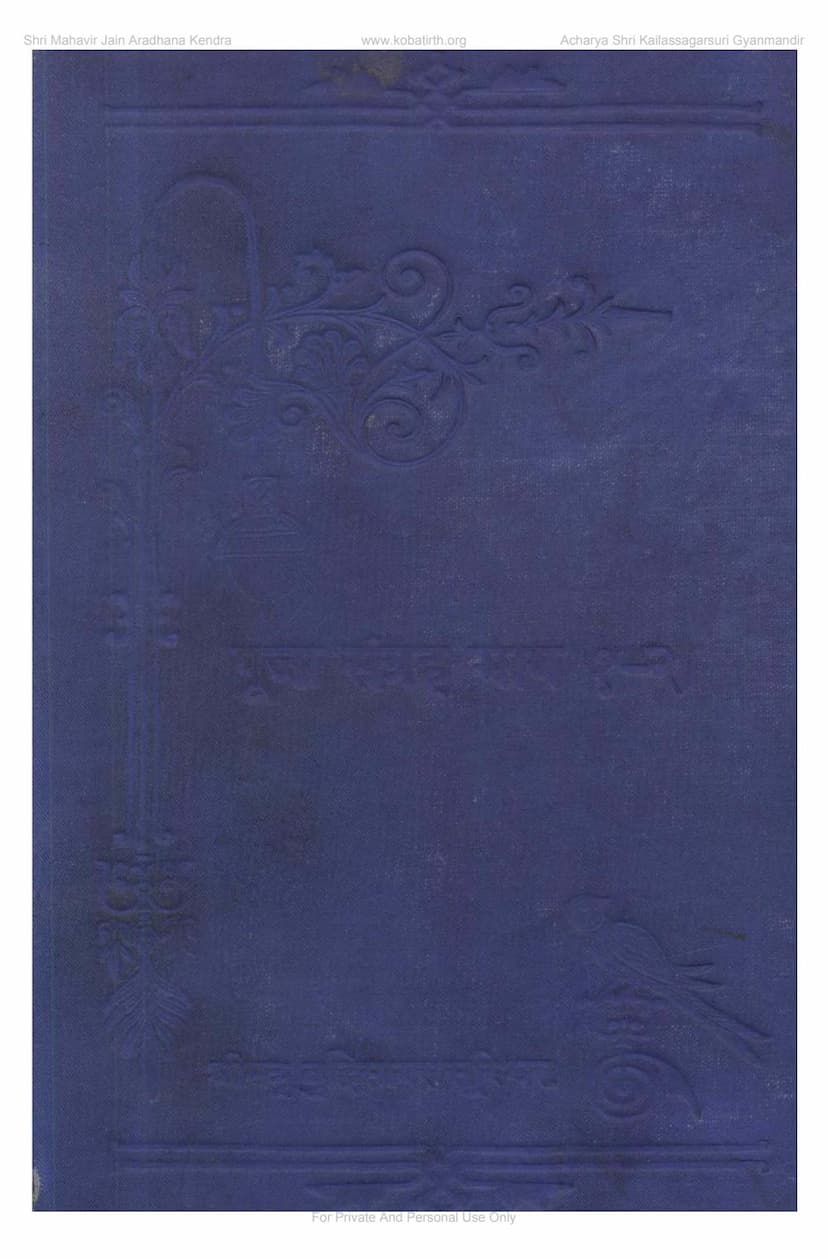Pooja Sangraha Part 3
Added to library: September 2, 2025

Summary
This is a comprehensive summary of "Pooja Sangraha Part 3" by Buddhisagar, published by Adhyatma Gyan Prasarak Mandal. The text is a collection of Jain devotional songs (pujas) and related spiritual content.
Overall Content and Purpose:
The book is a compilation of various pujas (devotional worship songs/prayers) composed by Acharya Buddhisagar Surishwarji. These pujas are intended for use in Jain religious ceremonies, daily worship, and to foster spiritual devotion and understanding among followers. The text emphasizes the importance of both dravya puja (worship through material offerings) and bhava puja (worship through inner devotion, faith, and contemplation of the divine qualities).
Key Themes and Concepts:
- Devotion to Tirthankaras and Gurus: The pujas are primarily directed towards the Tirthankaras, especially Lord Mahavir and Lord Parshvanath, and also towards the spiritual lineage of gurus, particularly Acharya Ravi Sagar Surishwarji and Acharya Sukh Sagar Surishwarji.
- Spiritual Principles: The text delves into various Jain philosophical and ethical principles, including:
- The nature of God and the soul: Disc. ssing the concepts of the soul's inherent purity and the path to liberation.
- The importance of knowledge, devotion, and conduct (Jnana, Bhakti, Charitra): Highlighting these as the core elements of spiritual practice.
- The distinction between material and spiritual worship: Emphasizing that while material offerings are part of the ritual, inner devotion and understanding are paramount.
- The path to liberation (Moksha): Outlining how following the teachings of the Tirthankaras and practicing virtues leads to freedom from the cycle of birth and death.
- The twenty-one qualities of a householder (Shravak): The collection includes a detailed puja dedicated to cultivating these virtues.
- The twelve reflections (Bhavana): Essential contemplative practices for spiritual progress.
- The five spiritual knowledges (Pancha Jnana): Explaining their significance in the Jain path.
- The importance of auspiciousness (Mangal): Including a puja for auspicious beginnings.
- The veneration of holy places (Tirtha): With pujas dedicated to both mobile (Jangam) and stationary (Sthavar) sacred sites.
- The avoidance of sins (Papa): Featuring a puja to overcome the eighteen cardinal sins.
- The Yoga path: Explaining the principles of Ashtanga Yoga and Panchadha Yoga within a Jain context.
- Author's Style and Approach: Acharya Buddhisagar is described as a prolific poet and spiritual scholar. His compositions are noted for their rich devotional sentiment, spiritual depth, and accessibility. He is credited with composing pujas on unique themes that had not been previously explored.
- Structure and Organization:
- The book is divided into sections, with the main focus being on various pujas.
- There are introductory sections (Upoḍghāt, Prastāvanā) that discuss the purpose of the collection, the author's mission, and the philosophy behind devotional worship.
- Biographical sketches of individuals who supported the publication are included, highlighting their contributions and devotion.
- The text includes a detailed index of the pujas, their themes, and the locations where they were composed.
- There is also a section on correcting errors (Ashuddhi Shuddhi Patrak).
- The latter part of the book features specific detailed pujas for:
- The twenty-one qualities of a Shravak.
- The seventy qualities of a Bhavashravak.
- The twelve vows of a householder (Dwadasha Vrata).
- The twelve reflections (Dwadasha Bhavana).
- The five auspicious events (Pancha Kalyanaka) of Lord Mahavir.
- The five types of knowledge (Pancha Jnana).
- Pujas for auspiciousness (Mangal Puja).
- Pujas for holy places (Jangam Sthavar Tirtha Puja).
- Pujas to overcome sins (Ashtadasha Papsthanaka Nivarak Puja).
- Pujas for specific deities like Shri Ghantakarna Mahavir.
- Various types of yogic practices (Ashtanga Yoga, Prana Yama, etc.) presented as devotional acts.
- Pujas for the Five Supreme Beings (Pancha Parameshti).
- Pujas for gurus.
- Pujas for various aspects of Jain dharma and practice.
- A detailed 'Snātra Puja' (ritual bathing ceremony) for deities.
- Navapada Puja (worship of the nine sacred syllables).
- Panchacharya Puja (worship of the five conduct rules).
- Vimshathanak Puja (worship related to the twenty stages).
- Sponsorship and Publication: The book was published with the financial support of generous individuals, and their contributions are acknowledged. The publication aimed to make spiritual literature accessible at an affordable price.
- Literary Merit: The pujas are described as poetic, filled with spiritual essence, and reflecting the author's deep devotion and poetic talent. They are praised for their ability to inspire devotion and lead the reader towards spiritual enlightenment.
- Critical Discourse: The text also includes a section discussing and refuting criticisms of certain devotional practices, particularly by comparing the author's compositions with those of other scholars and highlighting the perceived shortcomings of the critics' viewpoints.
Specific Pujas Highlighted (from the detailed index):
- Pujas for the twenty-one qualities of a Shravak (Householder).
- Pujas for the seventy qualities of a Bhavashravak (Spiritual Householder).
- Pujas for the twelve vows of a householder.
- Pujas for the twelve reflections.
- Pujas for the five auspicious events of Lord Mahavir.
- Pujas for the five types of knowledge.
- Pujas for auspicious beginnings.
- Pujas for holy sites (Jangam and Sthavar).
- Pujas to counteract eighteen sins.
- Pujas for Shri Ghantakarna Mahavir.
- Pujas for gurus like Ravi Sagarji and Sukh Sagarji.
- Pujas for the Pancha Parameshti (Five Supreme Beings).
- Pujas related to Ashtanga Yoga and other yogic practices.
- Pujas for the ritual bath (Snātra Puja).
- Pujas for Navapada and Vimshathanak.
In essence, "Pooja Sangraha Part 3" is a significant work in Jain devotional literature, offering a rich collection of prayers and spiritual guidance designed to deepen the understanding and practice of Jainism. It reflects the profound devotion and literary skill of Acharya Buddhisagar, aiming to uplift the spiritual lives of the readers.